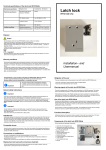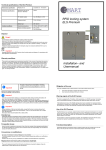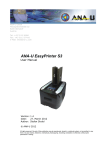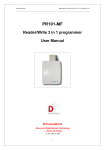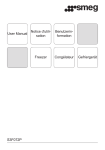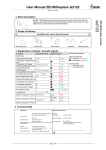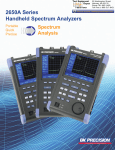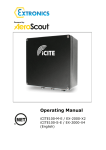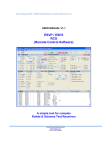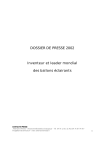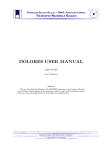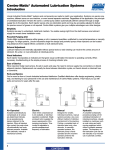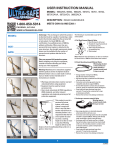Download Sliding door lock
Transcript
Technical specifications of the sliding door lock 13,56 MHz Mechanical specification Weight per Set Complete Set 200 Gramm Electrical specifications Equipment class as per Directive 1999/5/EC Class 2 HF radiation output max. 66 dBµA/m at 10m Frequency band 13,56 MHz, ISO14443A, ISO15693 Battery type CR 123A 3V Operating temperature +5°C bis +35°C (41°F to 95°F) Relative humidity operation 20% bis 75% (not condensing) Ambient conditions Sliding door lock for 13,56 MHz transponder supported transponders RF standards: - ISO 14443 A + B bis zu 424 kBit/s - ISO 15693 RF - Sony Felica - Inside Secure Disposal Danger! The electronics of the sliding door lock 13,56 MHz contains a lithium-ion battery. Dispose of this battery in accordance with national regulations. When disposing of partly discharged batteries, ensure that no accidental short circuits can occur between the poles of the battery (for example due to key fob in pocket of clothing…): danger of explosion and fire. Fasten the partly discharged battery for transport using non-conductive adhesive film in such a way that no short-circuits can occur. Selected with ISO 15693 supported transponders, e.g.: supported LEGIC transponders: - Texas Instruments Tag-It - LEGIC card-in-card Lösungen AFS - EM Microelectronics EM4035, - LEGIC prime MIM - LEGIC advant ATC / CTC - Infineon my-d - NFC Forum Tag 2 / 3 / 4-Typen Important! Separate electronics of the sliding door lock 13,56 MHz from the other parts and dispose of in accordance with local regulations and directives. - NXP Ultralight All with ISO 14443 A + B Teil 4 supported transponders, e.g.: - NXP Mifare Classic (UID) - NXP Mifare Desfire, - Sony Felica (Klartext) - Mifare Plus, SmartMX - Inside Secure (UID), HID iClass (UID) - Infineon SLE66 Warranty conditions Installation– and Usermanual This product was designed and manufactured carefully. At the moment of purchase the warranty amounts 12 months for material and manufacturing failures. The warranty starts with the date of purchase for 12 months. The product can be exchanged prior to certification of the proof of purchase. The warranty conditions are limited to costfree exchange of the product or repair. Costs and risks caused by transport, installation or de-installation of the product and all other costs caused by the repairing will not be compensated. Liability for consequential loss—no matter which type—are strictly excluded. Congratulations on your purchase of the sliding door lock 13,56 MHz. With this decision you have acquired locking technology with which you can lock and secure furniture without a key but nevertheless in a controlled, safe way. Important! The user’s manual must be accessible for operators. In addition, general and local regulations on accident prevention and environmental protection are to be observed. General safety instructions Important! If the door is closed when starting up or changing the battery without inserting the battery, the door cannot be opened via radio signals: it is necessary to break the door open. Follow the exact instructions for installation and start-up of the radio systems and replacement of the batteries. Remove the flat battery and to prevent a malfunction, wait at least 30 seconds before inserting a new battery. Observe correct polarity (+/-) at the battery case and the battery itself. Important! During installation of the lock and strike plate, ensure that the door is not pre-stressed and stresses are not transferred to the locking system. There is a risk that the latch can no longer open malfunction. Avoid doors which are pre-loaded with a rubber profile. Intended use Authorised opening of an electronic lock in wooden furniture with an encoded chip. This chip can be in the form of an ID-card (cheque card format) or key fob. Function of the lock is only warranted when mounted on not conductive materials (wood, plastic). The max. thickness of the material must not exceed 20 mm. If used with higher material thickness or metal doors or doors with metal coatings an external antenna must be used. Forseeable misuse Use of the lock in explosive environments. Use of the lock outside of the stipulated specifications. For damage resulting from incorrect use the customer bears sole responsibility, the manufacturer accepts no liability whatsoever. Conversions or modifications Any type of modification to the sliding door lock 13,56 MHz is not permitted. The electromagnetic conduct of the sliding door lock 13,56 MHz may be impaired by additions or modifications of any kind. Therefore do not carry out any modifications or additions to electric/electronic components. Replacement and wear parts and process materials The use of replacement parts from third-party manufacturers may lead to dangers. Use only original parts or parts approved by the manufacturer. Obligation of the user The user undertakes only to allow persons to work with the sliding door lock 13,56 MHz who: • have been instructed in working with the sliding door lock 13,56 MHz • have read and understood this user’s manual. Warning signals of the sliding door lock 13,56 MHz The lock is equipped with a 3V battery, which guarantees up to 20,000 openings. The battery level is automatically checked if no opening by radio signal has taken place within 30 days. If the battery level is low or the 20,000 openings have been exceeded, the necessary battery replacement is indicated by an audible signal. Under certain circumstances, the signal may last for several days, in which case automatic unlocking of the lock takes place. Aim of the sliding door lock 13,56 MHz The sliding door lock 13,56 MHz is a compact, wireless furniture lock for cupboards and sliding doors. It is opened with an electric motor, when closed the system locks itself. Contactless chip technology is used as the “key”. The system is “woken up” and opened by contactless identification via an authorised ID medium on the door. The ID medium is simple to programme or delete. The installation of the lock with the springpowered door opener is possible without drilling holes in the piece of furniture. Functional description Authorised opening of an electronic lock in wooden furniture with an encoded chip (= ID medium). This chip can be in the form of an ID-card (cheque card format) or key fob. Components of the sliding door lock 13,56 MHz The set contains the following components: Sliding door lock with changeable case closing part with break 2 pc pins for closing part Battery CR123A Stickers with Logo 8 pcs screws Tool to replace the case Manual Sliding door lock 13,56 MHz installation Program the Latch lock 13,56 MHz When unpacking, check whether the components as per the description are present. Dispose of the packaging in accordance with the applicable regulations of your country. Insert battery 1. 2. 3. 4. Normally the battery compartment is already open, the cover with screws is contained in an accessory bag. Otherwise, open the battery compartment by unscrewing the two M3x6 screws. Remove the battery from the blister pack. Insert the battery into the battery compartment. Observe correct polarity. Screw on the battery case cover with the M3x6mm screws provided. The device is ready for programming. On delivery, the lock is neutral. Programming can be carried out/altered at any time, as described in the following. Standard configuration means wheater the programming card nor the transponder is programmed. The audible signal is „on“ and the mode „standard“ is activated (automatically closing of the latch). 1.) Store Super Master card (special card): press the programming button of the lock until a long signal tone starts and immediately afterwards a ticking is audible for approx. 10 seconds. During the ticking, you must hold the Super Master card against the card reader panel, until a confirmation tune is audible. TheSuper Master card is now stored. Note: When using a new Super Master card the memory will be erased (long signal). 2.) Store Group Master card (special card): hold the stored Super Master card once against the card reader panel. A ticking is audible for approx. 10 seconds. During the ticking, hold the first Group Master card against the card reader panel to read it in, until a confirmation a long signal is sounded, the ticking continues, it will now be another 4 Group Master cards stored. If no other more Group Master card is created, the ticking ends after about 10 seconds. The Grooup Master card(s) is (are) now stored. Note: Per lock can max. 5 Group Master cards are created. 3.) Store transponder: hold the stored Group Master card once against the card reader panel. A ticking is audible for approx. 10 seconds. During the ticking, hold the transponder (key fob or card) against the card reader panel to read it in, until a confirmation a long signal is sounded, the ticking continues, it will now be another transponder stored. If no other more transponder is created the ticking ends after about 10 seconds. The transponder(s) is (are) now stored. Note: Per Group Master card can max. 64 transponders are created (max. 5 x 64 = 320). 4.) Delete stored transponders individually: hold the relevant Group Master card two times on the card reader panel. A fast ticking is heard for approx. 10 seconds. During the fast ticking, hold the transponder against the card reader panel to delete it, until a confirmation signal is sounded, the ticking continues, it will now be another transponder to delete. If no other more transponder is deleted, the ticking ends after about 10 seconds. The transponder(s) is (are) deleted. Sliding door lock 13,56 MHz general survey 5.) Delete all stored transponders from a Group Master card: hold the relevant Group Master card five times on the card reader panel, until a long signal is sounded. All transponders from this Group Master card are deleted, the latch is moved into the open position. Note: All other tranponders of other Group Master cards remain stored and function. Screwing holes Programming button Spezial programming connector 6.) Delete storedGroup Master cards individually: hold the stored Super Master card two times on the card reader panel. A fast ticking is heard for approx. 10 seconds. During the fast ticking, hold the Group Master card against the card reader panel to delete it, until a confirmation signal is sounded, the ticking continues, it will now be another Group Master card to delete. If no other more Group Master card is deleted, the ticking ends after about 10 seconds. The Group Master card(s) is (are) deleted. Note: Deleting the Group Master card also deletes all tranponders of this Group Master card. 7.) Delete all stored Group Master cards: hold the stored Super Master card five times on the card reader panel, until a long signal is sounded. All Group Master cards from this lock are deleted, the latch is moved into the open position. Note: Deleting all Group Master cards also deletes all tranponders of this lock. 8.) Open the latch e.g. with Super Master card or Group Master cards and hold the latch in this position: Put the Super Master card or one of the Group Master cards 4 times on the card reader panel. The latch will hold open until a authorised transponder will reset the hold open function. Note: All saved transponders are stored, the latch is moved into the open position. Card reader panel Install sliding door lock 13,56 MHz on furniture body and door EEC Declaration of Conformity in accordance with the directives 2004/108/EC 1999/5/EC 1999 2002/96/EC 2003 2011/65/EC for the product: Important! Directive on electro-magnetic compatibility (EMC) Directive on radio equipment and telecommunications terminal equipment and the mutual recognition of their conformity (R&TTE) Directive on waste electric and electronic equipment (WEEE) Directive on the restriction of the use of certain hazardous substances in electrical and electronic equipment (recast) Sliding door lock 13,56 MHz Assembling distance ca. 20 cm Important! RFID Card reader distance LEGIC Key fob up to 15 mm LEGIC card up to 25 mm Check reading distance after assembling the sliding door lock 13,56 MHz! Note! The lock assembly of furniture and the closing part must always be mounted so that the door in the closed state has at least 0.5 mm distance. This tolerance is necessary for the emergency opening in case of the low battery. Make sure that the transponder used have a very good reading quality. There should always be a comfortable reading distance be available from the front of the cabinet of at least 5-10 mm . The mounting distance between two locks should be approx. 20 cm. There is otherwise a risk of interference of the fields of the card reading panels. That can cause discharge of the battery. The following harmonised standards are applied: EN 300330.2 V1.3.1 : 2006 EN 301489-3 V1.4.1 : 2002 EN ISO 12100: 2010 EN 50364 : 2010




